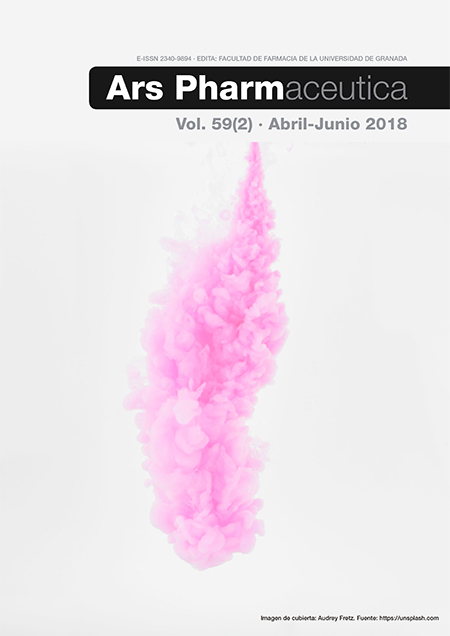Metodología de detección de Gliclazida en muestras biológicas
Palabras clave:
gliclazida, métodos analíticos de investigación, análisis químico-toxicológicoResumen
Objetivo: Desarrollar un método de detección de gliclazida en muestras biológicas para el diagnóstico analítico de los fallecimientos por sobredosis del fármaco.
Materiales y métodos: Método de CCF: placas para cromatografía Merck silica gel 60 F254 de 10×10 cm de tamaño, fase móvil - acetato de etilo, revelador - solución al 1% de vainillina o solución al 5% de hidrato de cloral. Método de HPLC: cromatógrafo líquido «Milihrom-A-02» con detección de UV (Rusia); columna de fase inversa Prontosil-120-5-C18-AQ de Ø2 x 75 mm, con graneado de 5 mm («Bischoff Analysetechnik und Geräte GmbH», Alemania); elución gradiente con una mezcla de dos eluyentes (eluyente A - [0,2 M solución de LiClO4 - solución de HClO 0,005 M4] y eluyente B - acetonitrilo); la longitud de onda es de 230 nm.
Resultados y discusión: Se desarrolló una metodología de determinación de la gliclazida en muestras biológicos, que incluye un método eficaz de aislar la gliclazida de los objetos de estudio, unos métodos cromatográficos específicos y selectivos de detección y cuantificación de la sustancia tóxica en los extractos obtenidos. Se constató que al aplicarse el método de CCF la gliclazida ha sido identificada de acuerdo con el valor Rf 0,48±0,01; el límite de detección es de 3,0 µg. Al aplicarse el método de HPLC se constató lo siguiente: el tiempo de retención de la gliclazida es de 7,80 min (RSD=0,13%), el límite de detección es de 0,050 µg/ml, el límite de cuantificación es de 0,157 µg/ml, la linealidad del método está en el intervalo de 0,1-20,0 µg/ml. En condiciones diseñadas la gliclazida se detectó a un nivel de 17,48±1,32µg/ml (RSD=6,06%).
Conclusiones. Los resultados obtenidos confirman que la metodología desarrollada de detección de la gliclazida en muestras biológicos es adecuada para el diagnóstico analítico de los fallecimientos por sobredosis del fármaco.
Descargas
Citas
Pekareva EV. Advantages Gliclazide MB usage in patients with type 2 diabetes mellitus. Problems of endocrinology 2012; 58: 58-61.
Smirnova OM, Kononenko IV. Usage of Diabeton MV in the treatment of type 2 diabetes mellitus and prevention of its late complications. Pharmateca 2011; 16: 30-36.
Side_effects – [Electronic resource]. – 2015. – Access: http: //patientaville.com.
Kucher TV, Merzlikin SI, Kovalenko EV. Chromatographic detection of glibenclamide in biological objects in the modeling of combined poisonings with drugs. Bulletin of Pharmacy 2016; 1: 28-33.
Levine M, Ruha A, Lovecchio F. Hypoglycemia after accidental pediatric sulfonylurea ingestions. Pediatr Emerg Care 2011; 27: 846-49.
Gul M, Cander B, Girisgin S. The effectiveness of various doses of octreotide for sulfonylurea-induced hypoglycemia after overdose. Adv Ther 2006; 23: 878-84.
Kucher TV, Merzlikin SI, Schtrigol SY. Investigation of the distribution of glibenclamide in animal organs in the design of acute intoxication. ScienceRise 2016; 3: 7-12.
Kartashov VA. Chemico-toxicological analysis. P. 1. Isolation of toxic substances from biological objects. Maikop: «Quality Ltd.», 2008.
Descargas
Publicado
Cómo citar
Número
Sección
Licencia
Los artículos que se publican en esta revista están sujetos a los siguientes términos en relación a los derechos patrimoniales o de explotación:
- Los autores/as conservarán sus derechos de autor y garantizarán a la revista el derecho de primera publicación de su obra, la cual se distribuirá con una licencia Creative Commons BY-NC-SA 4.0 que permite a terceros reutilizar la obra siempre que se indique su autor, se cite la fuente original y no se haga un uso comercial de la misma.
- Los autores/as podrán adoptar otros acuerdos de licencia no exclusiva de distribución de la versión de la obra publicada (p. ej.: depositarla en un archivo telemático institucional o publicarla en un volumen monográfico) siempre que se indique la fuente original de su publicación.
- Se permite y recomienda a los autores/as difundir su obra a través de Internet (p. ej.: en repositorios institucionales o en su página web) antes y durante el proceso de envío, lo cual puede producir intercambios interesantes y aumentar las citas de la obra publicada. (Véase El efecto del acceso abierto).




















